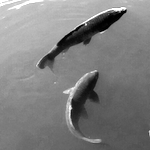After an introduction on the collective phases of fish schools, I will briefly present a general procedure to explicitly measure social interactions (attraction/repulsion; alignment) in animal groups. The reconstructed interactions can then be directly implemented in analytical models which quantitatively reproduce the collective motion of fish. I will also briefly address an alternative machine learning approach designed to produce realistic fish trajectories. In the second part of the talk, I will discuss several applications of such analytical or machine learning behavioral models in the context of robotic and drone platforms, as well as a virtual reality setup... for fish. In particular, our robot-fish and VR setup provide original tools to study the social dynamics of a fish school and its response to controlled perturbation.
|
|
|
|
Measuring and modeling social interactions in fish schools and applications: AI, robot-fish, virtual reality for fish, drones
1 : Laboratoire de Physique Théorique Université Toulouse III - Paul Sabatier, Centre National de la Recherche Scientifique, Fédération de recherche « Matière et interactions »
|

 PDF version
PDF version
